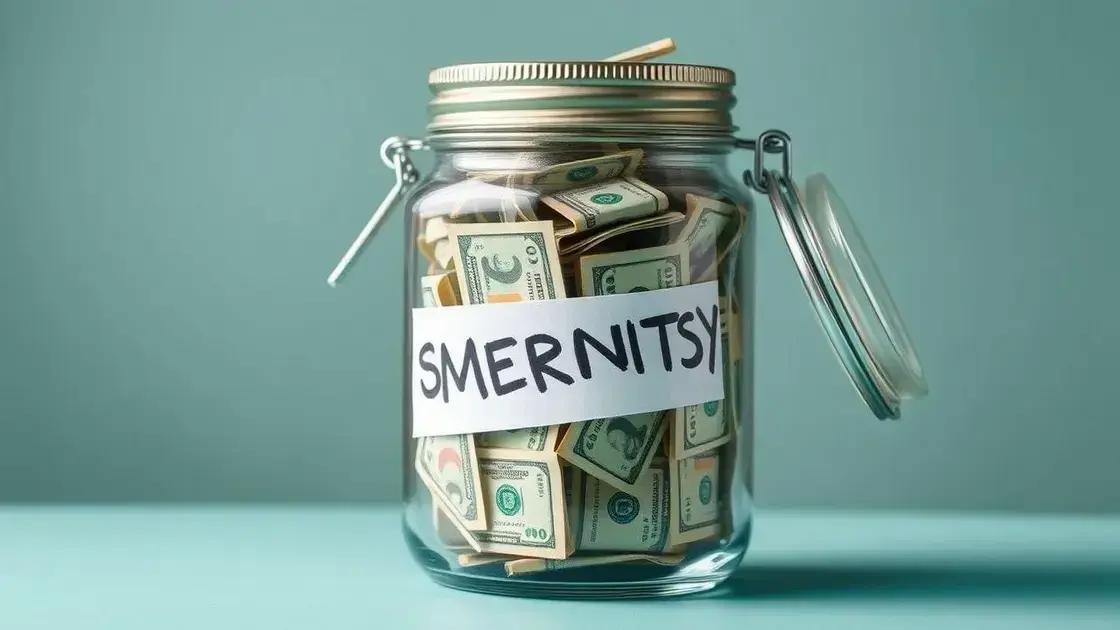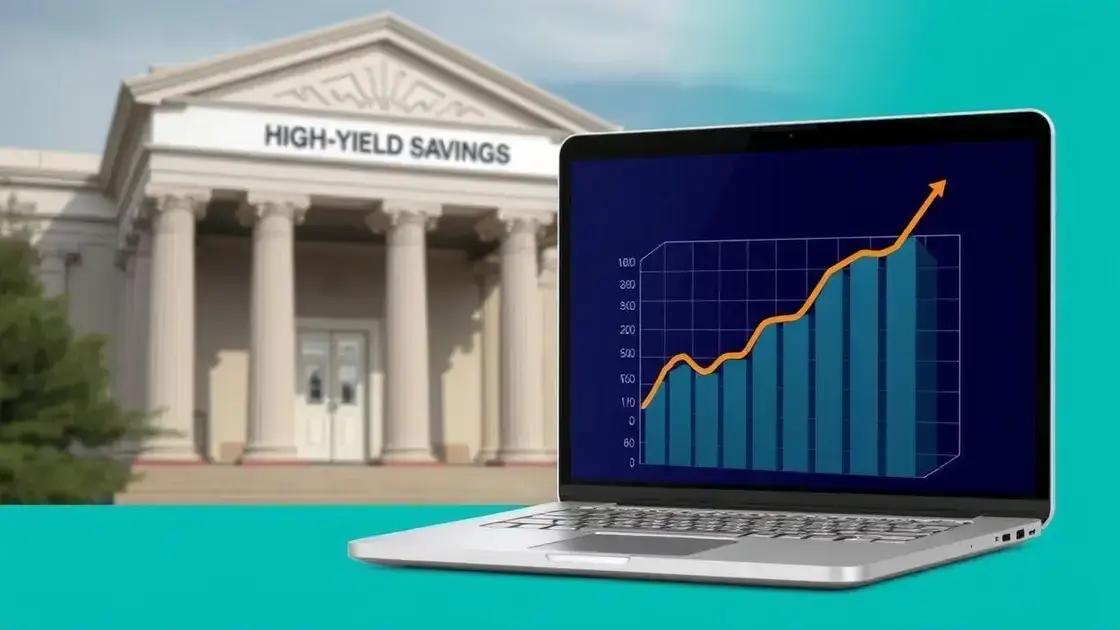Emergency fund: why it’s essential for financial security

Anúncios
An emergency fund is a dedicated savings account for unexpected expenses, typically covering three to six months of living costs, ensuring financial stability without incurring debt.
Having a strong emergency fund can make all the difference in your financial stability. Wondering why it’s essential? In this article, we’ll explore the key reasons you should prioritize building one.
Anúncios
What is an emergency fund?
An emergency fund is a savings account dedicated to unexpected expenses. It acts as a financial safety net, providing you with assurance during tough times. This fund allows you to cover costs like medical bills, car repairs, or job loss without going into debt.
Understanding the Importance
Having an emergency fund is crucial for anyone looking to maintain financial stability. When unexpected situations arise, this fund can keep you afloat. For instance, imagine your car breaks down. Instead of scrambling for money or borrowing, you can easily access your savings.
Anúncios
How Much Should You Save?
Experts often recommend building a fund that covers three to six months’ worth of living expenses. Here are some steps to determine the right amount for you:
- Calculate your monthly expenses, including rent, bills, and groceries.
- Multiply your total monthly expenses by the number of months you want your fund to cover.
- Consider your job security and personal comfort level when deciding how much to save.
Ultimately, the goal of an emergency fund is to ensure that you don’t have to compromise your financial health during tough times. Having this cushion allows for peace of mind, knowing you’re prepared for the unexpected.
Why having an emergency fund matters
Understanding why having an emergency fund matters is vital for achieving financial security. This fund acts like a safety net, ensuring that unexpected expenses don’t derail your financial health. In life, surprises can happen, and being prepared can alleviate stress significantly.
Avoiding Debt
One important reason for having an emergency fund is to avoid falling into debt. If unexpected costs arise, like medical bills or car repairs, having savings means you won’t need to rely on credit. This keeps you from accumulating high-interest debt that can spiral out of control.
Peace of Mind
Knowing you have funds set aside brings peace of mind. You can handle emergencies without panic. Instead of losing sleep over financial worries, you can focus on resolving your issues. Imagine getting a surprise medical bill, knowing that your fund will cover it can make a world of difference.
- Maintain a steady savings habit.
- Build resilience against financial hardships.
- Enhance your overall financial well-being.
In addition to these benefits, having an emergency fund gives you freedom. You’ll be ready for opportunities that come your way, whether it’s a last-minute travel deal or an investment. This flexibility can improve your quality of life, allowing you to enjoy moments without financial constraint.
How much should you save in your emergency fund?
Determining how much to save in your emergency fund is crucial for effective financial planning. The general recommendation is to have enough money to cover three to six months of living expenses. This amount can help you manage unexpected events without stress.
Calculating Your Needs
To figure out how much to save, start by calculating your monthly expenses. Include essentials like rent, utilities, groceries, and transportation. Knowing your total monthly outgoings can guide you to set a realistic savings target. For instance, if your monthly expenses total $2,000, aim for an emergency fund between $6,000 and $12,000.
Factors to Consider
Your individual situation also plays a significant role. Here are some factors to consider:
- Your job stability: If your job is secure, a smaller fund may suffice.
- Your family situation: More dependents typically mean higher expenses.
- Your lifestyle choices: If you maintain a higher lifestyle, consider saving more.
In addition, think about other financial obligations like debts or future large expenses. If you are in a volatile job market or have occasional big expenses, erring on the side of caution and saving more can provide peace of mind.
Ultimately, the goal of your emergency fund is to ensure you have enough savings to face life’s uncertainties without going into debt. Regularly review and adjust your funding goals as your circumstances change.
Where to keep your emergency fund

Choosing the right place to keep your emergency fund is essential for easy access and ensuring your money is safe. You want a balance between flexibility and earning some interest. Here are a few options to consider.
High-Yield Savings Accounts
High-yield savings accounts typically offer better interest rates compared to regular savings accounts. This option allows your money to grow while still being easily accessible when emergencies arise.
Money Market Accounts
Money market accounts can also be a good choice. They often provide higher interest than traditional savings accounts, and many allow check writing for quick access to funds. Be sure to check if there are minimum balance requirements.
- Look for accounts with no monthly fees.
- Choose accounts with easy online access.
- Consider accounts that offer mobile banking features.
Another option can be a certificate of deposit (CD), but it has limitations. CDs often have fixed terms, meaning you shouldn’t use them for your emergency fund if you may need quick access to cash. However, they can be part of your overall savings strategy if you’re comfortable locking away funds for a specific period.
Thinking about safety, avoid keeping your emergency fund in risky investments. The stock market may provide growth, but you could lose money when you need it most. Keeping it in a secure place helps you maintain your financial stability.
Tips for building your emergency fund
Building an emergency fund is a smart step toward financial security. To make this process easier, consider some practical tips that can help you grow your savings effectively.
Set a Savings Goal
Start by determining how much you want to save. Setting a clear savings goal gives you direction. This goal could be three to six months of living expenses. Make sure it’s realistic and achievable based on your income.
Create a Budget
Having a budget is essential for building your emergency fund. By understanding where your money goes, you can identify areas to cut back. Look for non-essential expenses that you can reduce. Use those savings to contribute to your fund.
- Track your spending for a month.
- Identify areas to save, like dining out or subscriptions.
- Redirect these savings into your emergency fund.
Additionally, consider automating your savings. Setting up automatic transfers to your savings account can help you grow your emergency fund without even thinking about it. This way, you prioritize savings as soon as you receive your paycheck.
Another helpful tip is to take advantage of any windfalls. Whenever you receive extra money, like tax refunds or bonuses, consider adding a portion to your emergency fund. This can give your savings a significant boost and help you reach your goal faster.
How to use your emergency fund wisely
Using your emergency fund wisely is crucial to maintaining financial stability. It is important to know when to dip into this fund and when to hold onto it. Understanding the right situations for using your savings can help you avoid unnecessary financial stress.
Identifying True Emergencies
Start by clearly defining what qualifies as a true emergency. Common reasons to use your emergency fund include:
- Unexpected medical expenses, like emergency room visits.
- Job loss or reduced income that impacts your ability to pay bills.
- Urgent car repairs that are necessary for work.
When faced with financial pressures, it’s important to assess whether the situation is a genuine emergency or if it can be managed through other means. If it’s not a true emergency, consider waiting until you have a clearer picture of your finances.
Replenishing Your Fund
If you do need to use your emergency fund, be sure to have a plan in place to replenish it. After using funds, create a realistic budget to rebuild your savings. This could involve:
- Setting aside a portion of your paycheck each month.
- Cutting down on discretionary spending.
- Using bonuses or tax refunds to go directly into the fund.
Using your emergency fund wisely means making thoughtful decisions about when to spend and ensuring that your financial safety net is intact. Always evaluate your situation carefully to maintain long-term stability.
Common mistakes to avoid with an emergency fund
Avoiding common mistakes with your emergency fund can help you maintain financial security. Many people make errors that can undermine their efforts to save effectively. Being aware of these pitfalls is the first step in ensuring your fund is used properly.
Not Having a Fund at All
One of the biggest mistakes is failing to build an emergency fund altogether. Without savings, unexpected expenses can lead to debt. Start small and gradually build your fund to cover at least three months of expenses.
Using it for Non-Emergencies
Another mistake is using your emergency fund for non-emergencies. Treat this fund as a safety net for true emergencies only, such as medical crises, car repairs, or sudden job loss. Think carefully before dipping into your savings for unplanned expenses that aren’t critical.
Lack of Replenishment Plan
Many people forget to plan for replenishing their emergency fund after using it. If you withdraw from your fund, have a strategy to rebuild it quickly. This might include budgeting a portion of your income specifically for this purpose.
Keeping it in Low-Interest Accounts
Lastly, storing your emergency fund in a low-interest savings account can limit growth. Consider high-yield savings accounts or money market accounts to earn more interest while keeping your money accessible for emergencies.
Recognizing these common mistakes can help you maintain a healthy emergency fund and ensure your financial security. Staying disciplined and informed is key to successful savings.
Emergency fund vs. savings account

Understanding the difference between an emergency fund and a traditional savings account is crucial for managing your finances effectively. Both serve important purposes, but they have different roles in your financial plan.
What is an Emergency Fund?
An emergency fund is specifically set aside for unexpected expenses, such as medical emergencies, car repairs, or job loss. This fund should be easily accessible and should typically cover three to six months of living expenses. The primary goal is to provide financial security during unforeseen circumstances without incurring debt.
What is a Savings Account?
A savings account is a general-purpose account used to save money for various goals, like vacations, purchases, or future plans. While funds in a savings account can also be accessed quickly, they are not specifically earmarked for emergencies and typically do not hold the same level of urgency.
Key Differences
Here are some key differences between an emergency fund and a savings account:
- Purpose: The emergency fund is used for unexpected situations, while a savings account is for planned goals.
- Funding Strategy: An emergency fund should be a priority, funded before other savings, to ensure you are protected in emergencies.
- Access: Both funds should be easily accessible, but it’s recommended to keep your emergency fund in a high-yield account for potential growth.
While both an emergency fund and a savings account are important, they should not be used interchangeably. Having both allows you to prepare for the unexpected while still saving for your future goals.
FAQ – Frequently Asked Questions about Emergency Funds
What is an emergency fund?
An emergency fund is a savings account specifically reserved for unexpected expenses, helping you avoid debt during financial crises.
How much should I save in my emergency fund?
It’s recommended to save three to six months’ worth of living expenses in your emergency fund for adequate coverage.
Where should I keep my emergency fund?
You should keep your emergency fund in a high-yield savings account or a money market account for easy access and some interest growth.
Can I use my emergency fund for non-emergency expenses?
No, your emergency fund should only be used for true emergencies, such as medical expenses or car repairs, to maintain its purpose.






